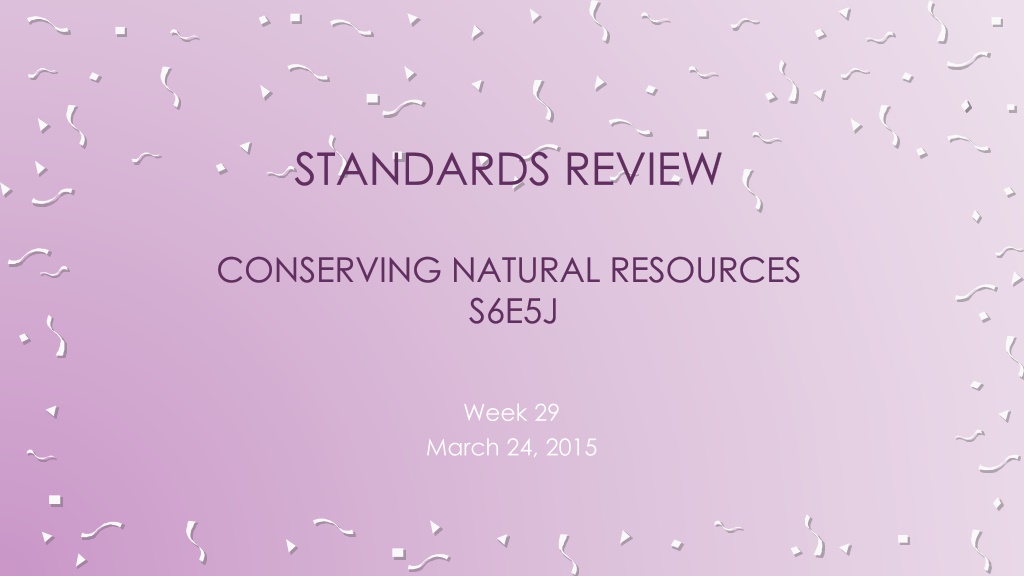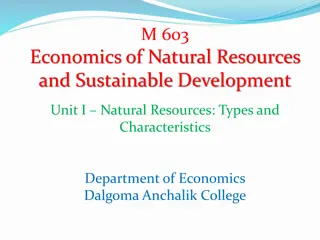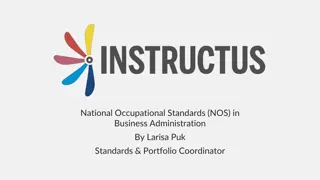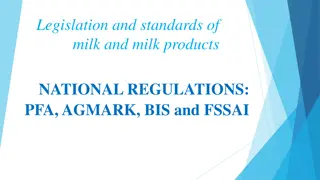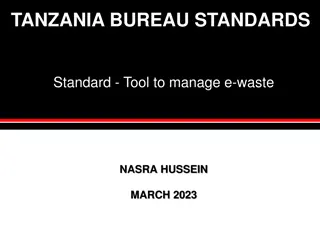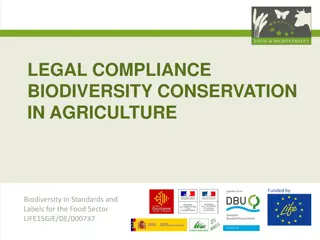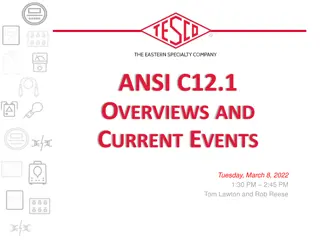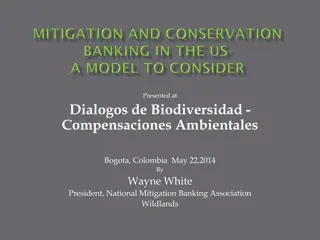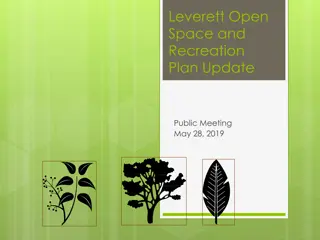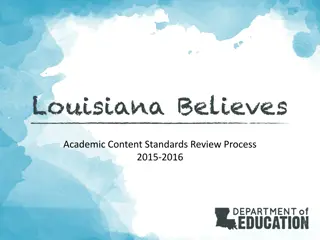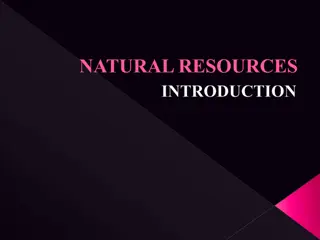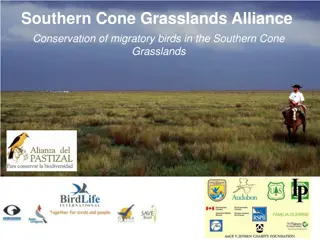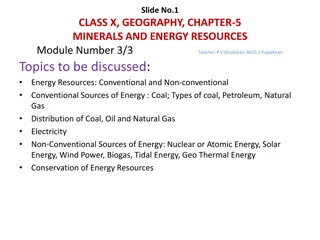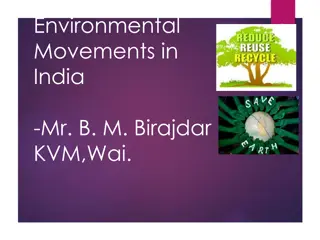Standards Review: Conserving Natural Resources Activities
Explore activities and tips related to conserving natural resources, including using wind energy, preventing soil erosion, conserving water at home, and reducing pollution. Test your knowledge on conservation efforts with engaging questions and scenarios. Learn ways to save natural resources through simple practices like fixing leaks, reducing water usage, and planting shrubs.
Uploaded on Sep 26, 2024 | 0 Views
Download Presentation

Please find below an Image/Link to download the presentation.
The content on the website is provided AS IS for your information and personal use only. It may not be sold, licensed, or shared on other websites without obtaining consent from the author. Download presentation by click this link. If you encounter any issues during the download, it is possible that the publisher has removed the file from their server.
E N D
Presentation Transcript
STANDARDS REVIEW CONSERVING NATURAL RESOURCES S6E5J Week 29 March 24, 2015
1. Non-renewable natural resources like oil and natural gas take a very long time to form. That is one reason for the building of windmill farms that produce electricity from the wind's movement. What is another reason? 2. Farmer Brown is planting crops in his fields. He wants to prevent the topsoil from being blown away by the wind or washed away by water. Which of these steps should he take? a. plow the soil many times b. plant crops close together c. water the crops often to wet soil d. leave the land free of crops for a long time a. Wind energy is more efficient than solar energy. b. The energy produced on a windmill farm is much cheaper. c. The energy produced on a windmill farm is much more expensive. d. Windmill farms produce energy without producing as much pollution. 3. Conserve means to save. We all want to save our natural resources. Elisa is trying to help her parents conserve water at home. What is one way Elisa can conserve water at home? 4. Limiting the amount of human waste and chemicals in run-off will decrease a. air pollution. b. soil pollution. c. water pollution. d. sound pollution. a. fix a leaky faucet b. run water while brushing teeth c. washing her hands before eating d. playing under the lawn sprinklers
1. Non-renewable natural resources like oil and natural gas take a very long time to form. That is one reason for the building of windmill farms that produce electricity from the wind's movement. What is another reason? 2. Farmer Brown is planting crops in his fields. He wants to prevent the topsoil from being blown away by the wind or washed away by water. Which of these steps should he take? a. plow the soil many times b. plant crops close together c. water the crops often to wet soil d. leave the land free of crops for a long time a. Wind energy is more efficient than solar energy. b. The energy produced on a windmill farm is much cheaper. c. The energy produced on a windmill farm is much more expensive. d. Windmill farms produce energy without producing as much pollution. 4. Limiting the amount of human waste and chemicals in run-off will decrease 3. Conserve means to save. We all want to save our natural resources. Elisa is trying to help her parents conserve water at home. What is one way Elisa can conserve water at home? a. air pollution. b. soil pollution. c. water pollution. d. sound pollution. a. fix a leaky faucet b. run water while brushing teeth c. washing her hands before eating d. playing under the lawn sprinklers
Use a broom instead of a hose to clean your sidewalks. Time your showers to keep them under five minutes. Check your faucets for leaks. Reduce the amount of grass in your yard by planting shrubs. 1. Which activity will help conserve our natural resources? a. watering the lawn everyday b. using only one side of the paper c. bringing cloth bags to the grocery store d. cutting down forests to build shopping centers 2. Which is the BEST title for this list? a. Tips to Conserve Water b. Tips to Conserve Energy c. Ways to Reduce Pollution 3. Which is the BEST way to conserve the Earth s forests? 4. Annie s teacher has asked the students to make posters on protecting the environment and conserving natural resources. Which of these activities should NOT be on her poster? a. Ride a bike to work. b. Set up a compost pile. c. Recycle paper products. d. Turn down your thermostat. a. cleaning up the beach b. reusing paper products c. turning off extra lights d. using single-use batteries
Use a broom instead of a hose to clean your sidewalks. Time your showers to keep them under five minutes. Check your faucets for leaks. Reduce the amount of grass in your yard by planting shrubs. 1. Which activity will help conserve our natural resources? a. watering the lawn everyday b. using only one side of the paper c. bringing cloth bags to the grocery store d. cutting down forests to build shopping centers 2. Which is the BEST title for this list? a. Tips to Conserve Water b. Tips to Conserve Energy c. Ways to Reduce Pollution 3. Which is the BEST way to conserve the Earth s forests? 4. Annie s teacher has asked the students to make posters on protecting the environment and conserving natural resources. Which of these activities should NOT be on her poster? a. Ride a bike to work. b. Set up a compost pile. c. Recycle paper products. d. Turn down your thermostat. a. cleaning up the beach b. reusing paper products c. turning off extra lights d. using single-use batteries
Renewable and Nonrenewable Resources S6E6.b 1. Which resource is a non-renewable and non-recyclable resource? a. Iron b. Gasoline c. Beef Cattle d. Rainforests 2. We can divide natural resources into two basic categories: renewable and nonrenewable. Consider the bar graph of resource usage. If we wanted to reduce the use of nonrenewable natural resources, it would be least important to a. reduce deforestation. b. conserve natural gas use. c. find alternatives to fossil fuels. d. reduce the number of vehicles on the roads. 3. Which is NOT a negative consequence of burning coal? a. causes water pollution and acid rain b. releases large amounts of carbon dioxide c. pollutes ocean water when drilling for coal d. causes lung cancer and other respiratory problems 4. Which of these is a renewable resource? a. Coal b. Geothermal c. Petroleum d. potash
Renewable and Nonrenewable Resources S6E6.b 1. Which resource is a non-renewable and non-recyclable resource? a. Iron b. Gasoline c. Beef Cattle d. Rainforests 2. We can divide natural resources into two basic categories: renewable and nonrenewable. Consider the bar graph of resource usage. If we wanted to reduce the use of nonrenewable natural resources, it would be least important to a. reduce deforestation. b. conserve natural gas use. c. find alternatives to fossil fuels. d. reduce the number of vehicles on the roads. 3. Which is NOT a negative consequence of burning coal? a. causes water pollution and acid rain b. releases large amounts of carbon dioxide c. pollutes ocean water when drilling for coal d. causes lung cancer and other respiratory problems 4. Which of these is a renewable resource? a. Coal b. Geothermal c. Petroleum d. potash
2. Over the last several decades, scientists have addressed the problem of nonrenewable natural resources such as fossil fuels. Humans are using fossil fuels at a rapid rate and scientists believe that one day we will run out of them. To solve this problem, research has been conducted on alternative energy sources. One alternative energy source is nuclear energy. Although nuclear energy is a good solution to this problem, there are concerns. 1. Building a dam to produce hydro-electricity power is one way to take advantage of a common renewable resource. This produces much less pollution than a coal burning plant. However, building dams is not a perfect solution. What is one problem related to dams? a. Dams do not produce enough electricity. b. Building a dam will disrupt the local ecosystem. c. There are not enough rivers that could be dammed up. d. They produce more pollution than many other sources of energy. Which of these is NOT a benefit of nuclear energy? a. fossils fuels are not required b. does not contribute to global warming c. presence of hazardous radioactive materials d. little carbon emissions released into the air 3. An example of a product made from a renewable resource is 4. Why is recycling aluminum cans beneficial? a. The quality of the aluminum can improves each time it is recycled. b. Aluminum is rarely used and it makes no sense to produce new cans. c. Aluminum is a very available mineral and commonly used for making cans. d. Recycling reduces the need to mine more aluminum and helps conserve this mineral. a. electricity made from coal. b. coal slurry made from coal. c. ethanol fuel made from corn. d. plutonium made from uranium.
1. Building a dam to produce hydro-electricity power is one way to take advantage of a common renewable resource. This produces much less pollution than a coal burning plant. However, building dams is not a perfect solution. What is one problem related to dams? 2. Over the last several decades, scientists have addressed the problem of nonrenewable natural resources such as fossil fuels. Humans are using fossil fuels at a rapid rate and scientists believe that one day we will run out of them. To solve this problem, research has been conducted on alternative energy sources. One alternative energy source is nuclear energy. Although nuclear energy is a good solution to this problem, there are concerns. a. Dams do not produce enough electricity. b. Building a dam will disrupt the local ecosystem. c. There are not enough rivers that could be dammed up. d. They produce more pollution than many other sources of energy. Which of these is NOT a benefit of nuclear energy? a. fossils fuels are not required b. does not contribute to global warming c. presence of hazardous radioactive materials d. little carbon emissions released into the air 3. An example of a product made from a renewable resource is 4. Why is recycling aluminum cans beneficial? a. The quality of the aluminum can improves each time it is recycled. b. Aluminum is rarely used and it makes no sense to produce new cans. c. Aluminum is a very available mineral and commonly used for making cans. d. Recycling reduces the need to mine more aluminum and helps conserve this mineral. a. electricity made from coal. b. coal slurry made from coal. c. ethanol fuel made from corn. d. plutonium made from uranium.
